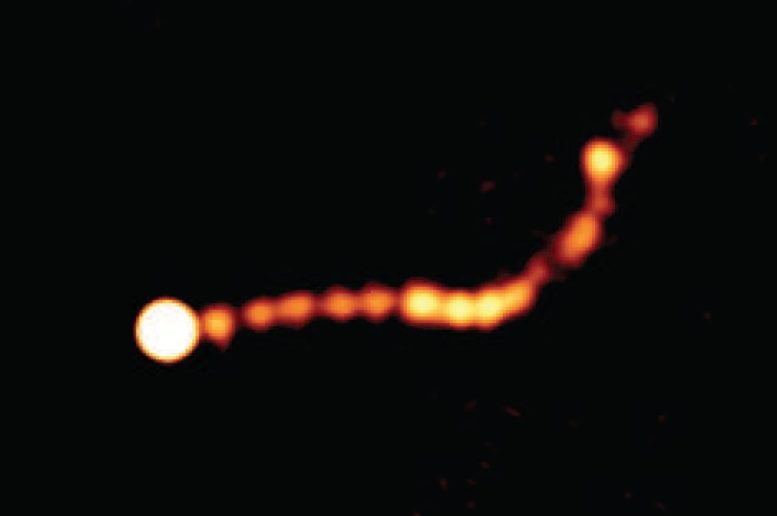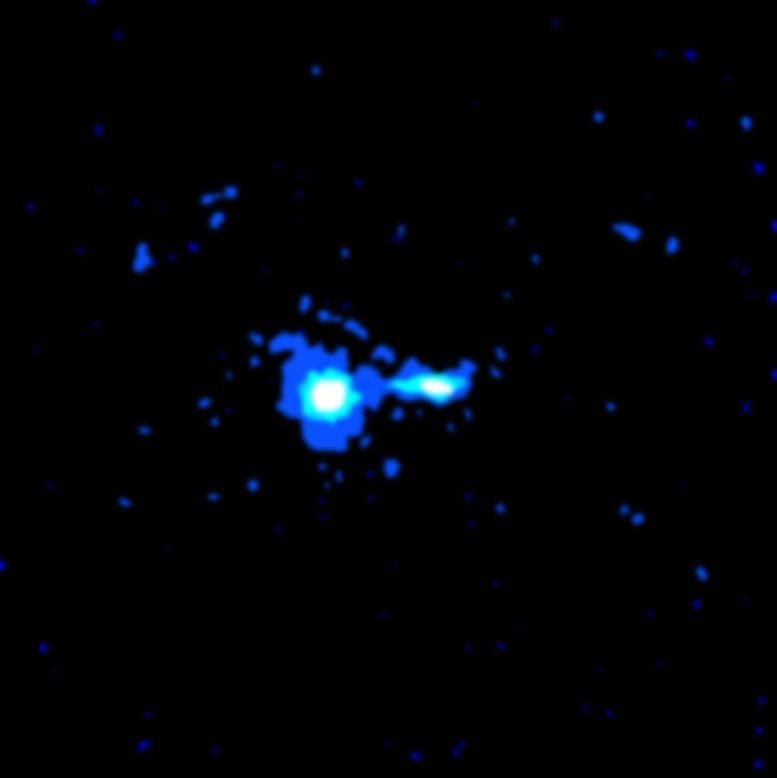
The jet known as ‘PKS 0637-752’ as seen by the Australia Telescope Compact Array (ATCA) in New South Wales, Australia clearly shows the shock diamond-like shapes in the two million light-year long structure. Credit: Dr. Leith Godfrey, ICRAR and Dr. Jim Lovell, University of Tasmania
This extended jet of cosmic materials, traveling near light speed, emerged from a distant galaxy. The flow is almost 2 million light-years long, at least 20 times larger than the Milky Way. Astronomers published their findings in the Astrophysical Journal Letters.
The outflow is coming from a distant quasar that was formed 6 billion years ago and is shining with the power of 10 trillion suns. It’s called PKS 0637-752 and is thought to be an early galaxy with a supermassive black hole in its center. When dust and gas fall into the black hole, they are spun around and this spiraling motion accelerates the charged particles like a particle accelerator.

PKS 0637-752 in the constellation Mensa. PKS 0637-72 is so distant that we see it as it was 6 billion years ago. It is a luminous quasar that radiates with the power of 10 trillion suns. The source of this prodigious energy is believed to be a supermassive black hole. Chandra’s X-ray image reveals a powerful X-ray jet extending away from the quasar that stretches across several hundred thousand light years. The jet, also observed by radio telescopes, is probably due to a beam of extremely high-energy particles. Credit: NASA/CXC/SAO
The image was taken by the CSIRO Australia Telescope Compact Array radio telescope in New South Wales, and shows off the radio wavelengths of the galactic jet. There are dot-like structures seen within the jet, which are intriguing to astronomers. These formations are known as knots and they aren’t very well understood. However, they seem to represent sections of the jet separated by 160,000 to 360,000 light-years each.
This odd pattern suggests that the jet is periodically turning off and on, or that some kind of shockwave within the jet is causing the knots. Astronomers are examining the data to better understand this object and its features.
Reference: “Periodic Structure in the Megaparsec-Scale Jet of PKS 0637−752” by L. E. H. Godfrey, J. E. J. Lovell, S. Burke-Spolaor, R. Ekers, G. V. Bicknell, M. Birkinshaw, D. M. Worrall, D. L. Jauncey, D. A. Schwartz, H. L. Marshall, J. Gelbord, E. S. Perlman and M. Georganopoulos, 27 September 2012, Astrophysical Journal Letters.
DOI: 10.1088/2041-8205/758/2/L27









Be the first to comment on "Distant Quasar Ejects 2 Million Light-Year Long Jet of Cosmic Material"